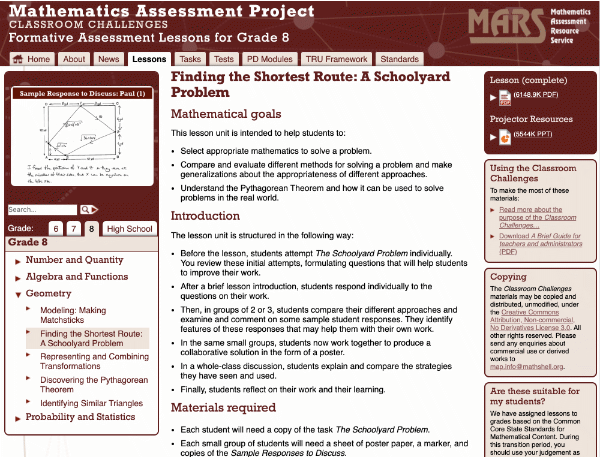30 Design Strategies and Tactics from 40 Years of Investigation
Appendix: Further information and examples
Student work designed for critiquing
The argument that students need experience of unstructured, open-ended tasks - with authentic problem-solving elements in which the correct ‘tools’ to use are not immediately obvious – has been made elsewhere. One challenge is that such tasks tend to have a range of solutions of equal validity but different levels of sophistication. In mathematics, for example, a problem may be soluble by a simple ‘guess and check’ approach at the expense of more ‘elegant’ and generalizable algebraic or graphical approaches. Although the learning aims of the lesson probably included the more advanced solutions, the ‘easy’ solution can’t be rejected and students may have difficulty in seeing the ‘payoff’ from a ‘harder’ solution. Specifically telling students to, say, “Solve it using linear equations” destroys the problem-solving elements of the task.

Link to materials
One technique used extensively in the formative assessment lessons developed by the Mathematics Assessment Project (MAP) is to first allow the students to spend time working on the problem and devise their own solution, then to follow up by asking them to critique samples of work from ‘other students’ showing a range of different techniques. Unlike the usual ‘specimen answers’ these are not model answers from an expert – some include outright mistakes to be spotted, all have room for improvement.




Enlarge…
‘Schoolyard Problem’ task and sample work







While the students are fictitious and the work has sometimes been created by the design team, it is inspired by actual student responses observed during trials and uses extracts copied from real work where possible. It reflects common mistakes and misunderstandings observed in real students as well as rarely seen, but desirable, sophisticated techniques.
Students could also compare and critique each other’s work, and this is also a feature of the MAP lessons. However, using ‘designed’ sample work ensures that students see the more sophisticated solutions and learn to recognize common mistakes. Also, having fictitious students to criticize can help avoid social tensions intruding on the learning. Some of the implications of these resources for teacher behavior are discussed in Evans & Ayalon (2016).
Links to materials:
- MAP problem-solving task with sample work
- >https://www.map.mathshell.org/lessons.php?unit=8305&collection=8, map_schoolyard.png
References
Evans, S., Ayalon, M. (2016) Can designed student responses support teachers to interact with students in a productive way? Educational Designer, 3(9). Retrieved from: http://www.educationaldesigner.org/ed/volume3/issue9/article33/